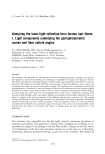USE OF DEOFIX TM IN DEODORANT PRODUCTS 257 O,8OO 0.800, ...... 20 4O 60 80 100 120 140 '-•--BHA Control '-•'- Deofix TM --•--Ethanol Control Time (min) Figure 5. The antioxidant activity of Deofix TM and BHA were compared to an alcohol control by measuring their effect on the coupled oxidation of carotene with linoleic acid. Decrease in the 470-nm absorption indicates a coupled oxidation is occurring between carotene and linoleic acid. 2.0 1.5 1.0 0.5 o.o -o,5 -1.o - !.o I , I , I . I ' ,I 0.2 0.3 0.4 0.5 0.6 Potential vs AgtAgCI, V Figure 6. Cyclic voltametry of DeofixTM in pH 7 buffer. than baseline response. Similar results were observed for the other pHs (pH 3-10). The results indicate that Deofix TM is not an active oxidant or reductant and that the mecha- nism of action for the antioxidant effect observed above is not related to its ease of oxidation as with classical antioxidants. SAFETY DATA The cytotoxity of Deofix TM is very low. Testing in the National Cancer Institute's revised anticancer screen (13) against neoplastic cell lines at five concentrations of ten- fold dilution was performed. A 48-hour continuous exposure protocol was used, and a sulforhodamine B (SRB) protein assay was used to estimate cell viability or growth. The
258 JOURNAL OF COSMETIC SCIENCE concentration of Deofix TM continuously present in the medium that was required to result in total growth inhibition (TGI) of 54 strains of various human neoplastic cells in vitro was high (14). In 38 of the cell lines studied the TGI was greater than 10-4M. In 16 cell lines that showed TGI values below 10-4M, the average TGI was 10-4'19M. The concentration that reduced the number of cells by 50% (IC5o) was greater than 10-4M in 49 of the tested strains. The inhibitory effect of Deofix TM on human foreskin fibroblast (HFF) cell growth was tested by suspending the cells in a growth medium containing Eagle's minimum es- sential medium and fetal calf serum. Cells were inoculated into tissue culture plates and incubated at 37 C. Cell growth was observed microscopically. HFF remained viable but failed to replicate when Deofix TM was continuously present in the growth medium in concentrations of 0.5 to 16 micrograms/mi. When HFF cells incubated in medium containing 16 micrograms/ml of Deofix TM were replaced with a medium free of Deofix TM, the cells appeared to resume replication consistent with a static, non-lethal, action of the Deofix TM (15). The effect of Deofix TM on HaCaT human keratinocytes was studied in vitro during continuous exposure of the keratinocytes to Deofix TM. Cultures were performed in microliter plates, and the number of cells was assayed by measuring DNA content in cultures using a DNA-binding fluorescent dye, Hoechst 33342. Fluorescence was moni- tored with a fluorescence plate reader. The viable keratinocyte numbers following 72- hour incubation with 240 micrograms/ml were only minimally changed from the viable keratinocyte number at the beginning of the study (16). Since the performance of a classical Ames test was complicated by the bacteriostatic effects of Deofix TM, the mutagenicity of Deofix TM was evaluated employing a specialized microbial assay system (17). The test uses dark mutants of luminous bacteria (Photobac- teria/eiogunthi) and determines the ability of the tested agent to restore the luminescent state. Deofix TM was found to be non-mutagenic by this assay. The iron complex of Deofix TM was not mutagenic when tested using the standard Ames assay. The Deofix TM chelator has very low acute toxicity following either intravenous or oral administration. In mice its LD50 following intravenous administration is approximately 1,900 mg/kg, while its LD50 following oral administration is in excess of 3,600 mg/kg. Following intravenous administration to mice, the bulk of the administered dose is excreted in the urine without demonstrable biodegradation. The agent has been applied to human skin in various vehicles in concentrations up to 2% without apparent adverse effects. The iron complex with the Deofix TM chelator administered intravenously in large daily doses for 14 days to rats and dogs failed to yield evidence of significant toxicity. The iron complex is currently being evaluated in human subjects to enhance image contrast in magnetic resonance imaging (MRI). In this complexed form it has been administered to over 270 human patients without significant objective adverse reactions. DISCUSSION Although the first commercial underarm deodorant appeared in the market in 1888, a true understanding of the origin of underarm odor awaited the work of Killian and
Purchased for the exclusive use of nofirst nolast (unknown) From: SCC Media Library & Resource Center (library.scconline.org)


























































































